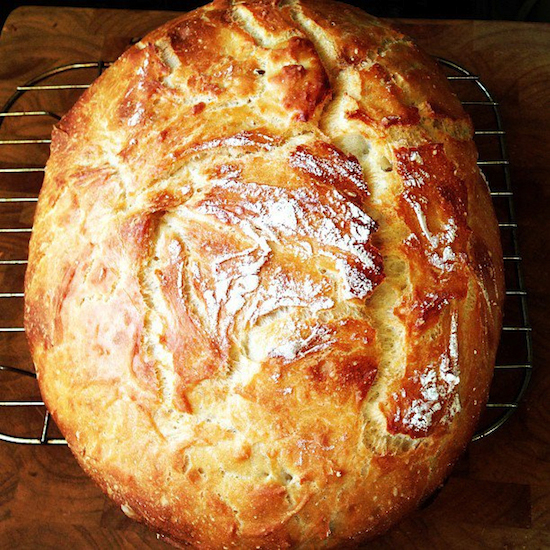
A couple of years ago, when mom was visiting from Baku, I wanted to proudly demonstrate my new baking skills to her. She watched curiously, expecting difficult techniques and methods, but soon realized that no specials skills were involved in the making; I mixed a few ingredients together, never kneaded anything but stirred with a spoon, let the mixture rise, then plopped it into my lidded pot to send the dough in the oven. She was, however, amazed by what came out of the oven—a beautiful, rustic, golden loaf that she confirmed could beat any store-bought bread out there. “This is just like the bread they baked in your grandpa’s bakery!” she exclaimed happily. I was even happier to hear that.
My maternal grandfather Najaf who I hear had a great business mind and loved baking, started a bakery in the 40s of the last century in the northwestern region of Balaken. The bread supplied the entire region with bread for many years. Sadly, the famous bakery did not last too long after grandpa passed away. I was born a year later. I used to always ask my mom about the kinds of bread they made in the bakery and whether there was any recipe preserved as I wanted to recreate it. Alas, the recipe was lost forever and nobody had it.
So, all of a sudden this bread that I baked in California became a connection. Mom said I didn’t need to look any futher and that this was the recipe and she even nicknamed the bread the “Najaf bread.” In my imaginary world I saw this tall, big, bold charismatic old man beaming with pride for the granddaughter he never met but who shared his passion for bread making and who actually made bread that looked and tasted like his. The granddaughter was beaming with pride, too.
Alright, enough of my imaginary world. Let’s learn how to make this amazing bread.
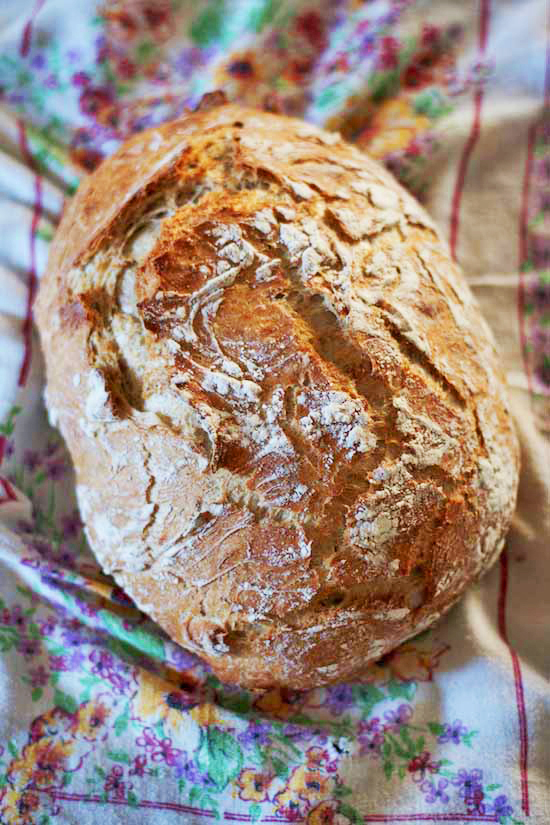
So what is this bread all about? Can you make it, too and have your family beam with pride for your baking skills? You sure can. In fact, I dare say this will be the easiest bread you will ever make in your entire life (bread machines not counting). And you will love it so much that you will never buy bread from a store. Not only this bread is easy to make but it is real, it is rustic, it is fresh, and it is home made, so you know exactly what’s in it.
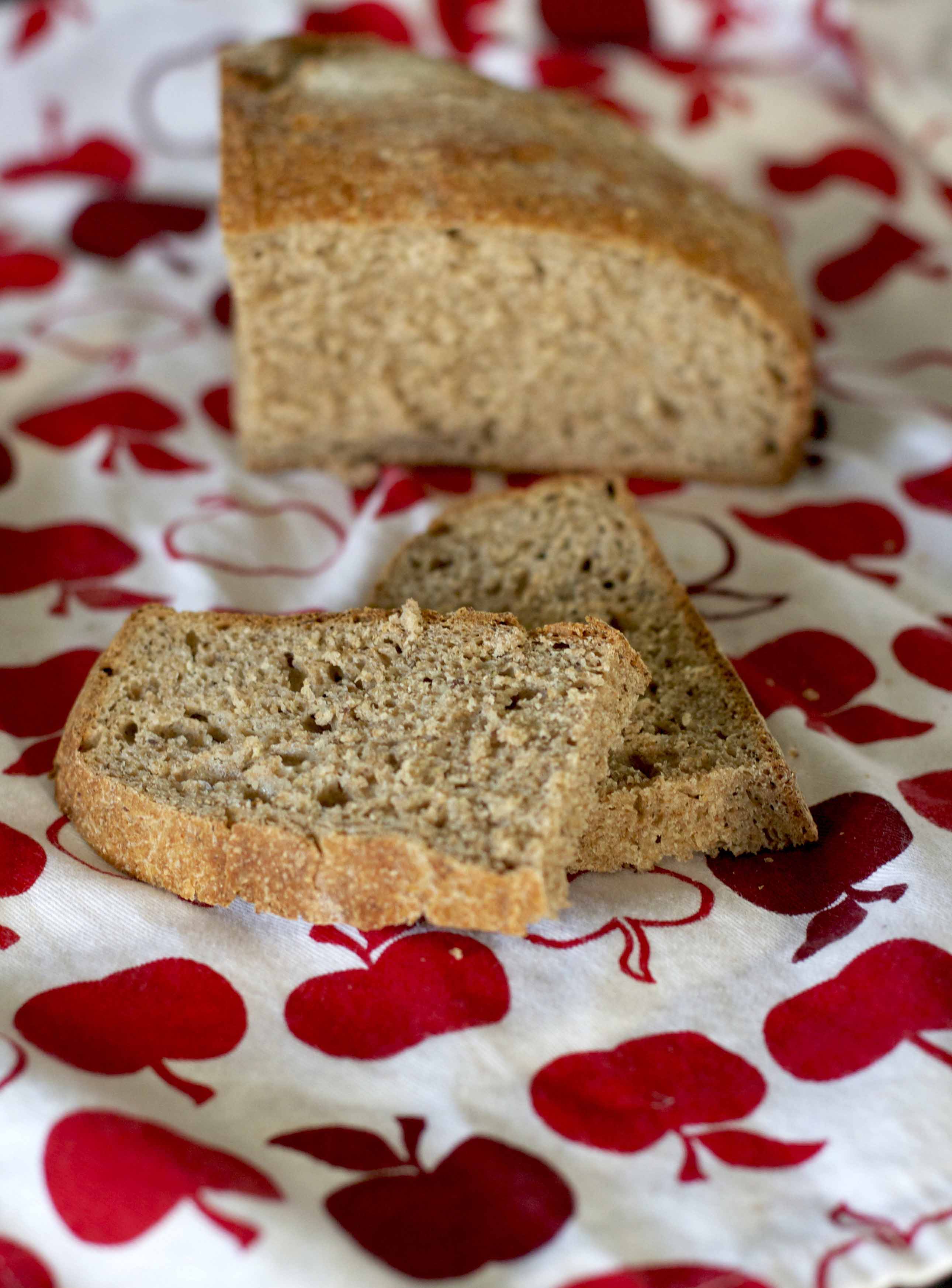
This bread, my friend, is called a no-knead bread. It is the revolitionary bread that was published in New York Times back in 2006 based on the reipe from Jim Lahey from Sullivan Street Bakery. The recipe was on my to-do list ever since and I finally gave it a try using the adaptation from my blogger friend Sofya’s wonderful blog. I never looked back. I’ve been in love with it ever since. I’ve been baking this bread non-stop for the past 3 years.
As the name suggests, there is no going into the dough with hands, kneading it for minutes until it is smooth. You leave the job to a spoon to do this. The rest is even easier.There are only a few ingredients you will need to make this bread–flour, salt, yeast, and water. The original recipe is for white bread, but I’ve adapted it to bake whole wheat bread and loved the result. To make white bread, I use unbleached all-purpose flour, for whole wheat—whole wheat four and a small amount of flaxseed meal.
So the simplest of doughs, a pot, a hot oven, and let the baking begin!
Here’s how. Let’s start with whole wheat bread.

First, we combine flour and salt in a large bowl.

We add dry yeast to warm water, let it foam, then add the mixture to the flour.

Then we begin to stir; no mixer or any fancy gadget involved. Just a wooden spoon.

We stir the mixture until the ingredients are well blended. The mixture will be lumpy and sticky. This is absolutely fine.

Then we cover the bowl with a lid or anything your heart desires. A plastic wrap will work, too. I use a cake pan and works fine. Next, we wait for the dough to rise, for an hour and a half.

Voila! The dough has risen! It should double in bulk.

Next, we sprinkle some flour on our working surface (in my kitchen it is granite countertop).
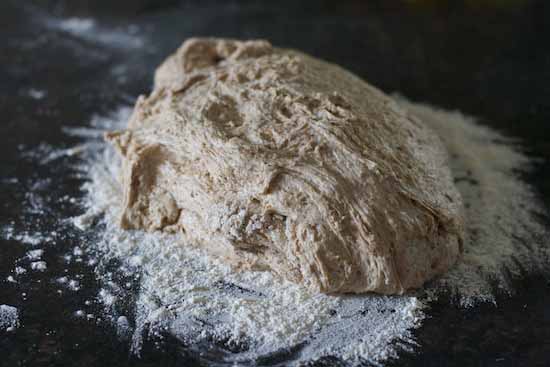
We scrape the dough from the bowl onto the flour.

Then we fold the dough in half, then again. The direction doesn’t matter. You can fold it the same way as the first one, or the opposite way. I’ve tried both ways—really no difference.

Then we leave the dough to rest, seam side down or seam side on the side—no big difference.

We cover the dough with the bowl and let it rest for 30 minutes. What do we do while the dough is resting and rising? We heat the oven to 470ºF (240ºC) and send our pot with the lid on in the oven to heat there for 30 minutes.

The dough is ready to bake now!
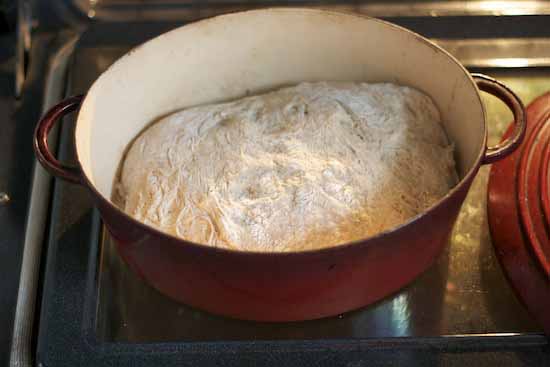
All we do is plop the dough into the hot pot (hot hot – be really carefully when handling the pot). Seam side up. Do not worry about the mess and no need to neatly level anything. The messier the top of the dough looks the more rustic the bread will be.
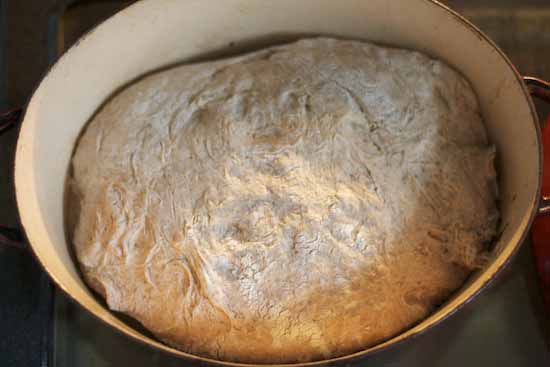
Here’s the bird view of our dough.

Off goes the pot in the hot oven!

We bake the bread for about 30 minutes. Then we remove the lid and bake it for another 10 minutes until the top is golden. Beautiful, isn’t it!
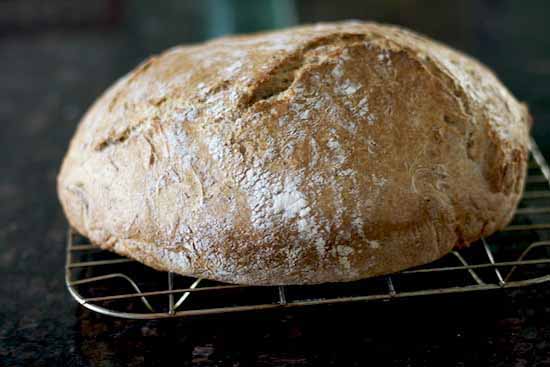
We carefully invert out bread onto a cooling rack and let it cool completely. Yes COMPLETELY! This is key. If you cut the bread early, it will be soggy (been there, no good).
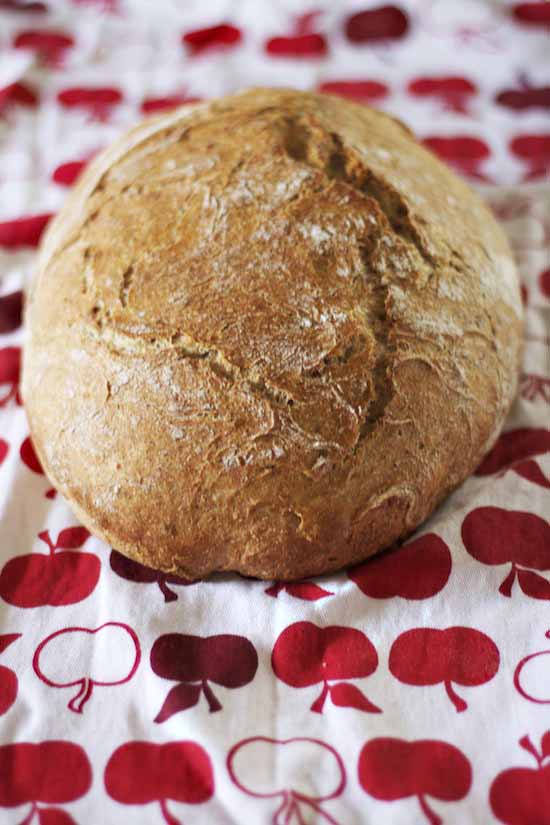
Here’s my whole wheat glory. I feel like bragging.

I love the cracks on top. Rustic bread is the best!

This is the picture of white bread dough. The concept is exactly the same. The only difference is all-purpose flour instead of whole wheat. This is how a risen white bread dough looks.

And here’s the dough ready to go in the oven.

A bird’s view of the dough for white bread.

Baked! You will love the crust on this one! I find that the crust on white bread is really rustic whereas whole wheat bread crust is softer. Both are great!
No-Knead Whole Wheat Bread
Adapted from The Girls Guide to Guns and Butter
The original recipe appeared in New York Times.
Note: You can use half all-purpose, half whole wheat flour if you want, but I love the texture and taste of a 100% whole wheat bread more. You can also experiment with adding other whole grain flours—a mixture of a few would be great. I plan on trying making the bread with rye flour, for example.
Ingredients
5+3/4 cups whole wheat flour
1 tablespoon salt
1/4 cup flaxseed meal (optional, you can omit it and use whole wheat flour instead)
2 teaspoons active dry yeast
3+1/2 cups warm water
You will also need
1 large Le Crouset enameled cast iron pot (that’s what I use), or Dutch oven, or plain cast iron pot. All must have a lid.
Directions
Make the dough: In a large mixing bowl, combine the whole wheat flour, salt and, if using, flaxseed meal. Sprinkle the dry yeast into the warm water and let sit for 5 minutes, or until frothy. Add the yeast water to the flour. Now, stir the mixture with a wooden spoon, until all the ingredients have well blended. The dough will be sticky and lumpy and this is absolutely how it should be. If, however, it is too sticky, add more flour, but do not overdo. Cover the bowl; you can use a tray, an inverted cake pan, or plastic wrap. Set the dough aside to rise, for 1 +1/2 hours, until it has almost tripled in size and the surface is somewhat bubbly.
Shape the dough: Sprinkle your work surface with flour—you can use whole what, all-purpose, or cornmeal. Using a spatula or a wooden spoon or your hands (they will get sticky but I don’t mind), dump the dough onto the floured surface. Now fold the dough once, like a book, then repeat; the direction does not matter. Put the dough seam side down and cover with a clean bowl. Let the dough rise under the cover for another 30 minutes.
Prepare your pot: While the dough is rising, put your Dutch oven or enameled cast iron pan, or a simple cast iron pan, lid on, in the oven and preheat your oven to 470ºF (240ºC). Let the pan sit there for 30 minutes while the dough is rising.
Bake the bread: Now the dough is ready to bake. Remove the hot Dutch oven from the oven. Be extra careful as it is really hot and may burn you! Transfer the loaf into your pot, seam side up (this will make for beautiful rustic cracks on the baked bread.) Cover the pot with the lid and send it into the oven. Bake for 30 minutes, without opening the lid of the pot. Then remove the lid (it is hot! hot!) and bake the bread for another 10 minuter or until the top is golden brown. Carefully remove the pot from the oven and invert the bread onto a cooking rack. Let the bread cool completely before slicing it, otherwise it will be soggy if cut while hot or warm.
No-Knead White Bread
To make white bread, follow the recipe for the whole wheat bread, using 6 cups unbleached all-purpose flour instead of whole wheat flour and flaxseed meal. The rest is the same.






Hmmm looks delicious! I have been making this no-knead bread for the past 2 years! I eat a couple of slices every morning for breakfast, just fantastic!
Wow, that looks absolutely gorgeous, cannot wait to make one. I love your website and recipes are just the ones I grew up with. I would like to ask your advise please. Were, in USA, can I get a maggash (or makkash) and ‘Baku style’ rolling pin (you know, the really skinny on the ends slightly fatter in the middle)? I live in NJ, have searched internet over and over, could not find it. Thank you.
NOW I see whom you have inherited your love to baking from ) Looks delicious, thank you for recipe
I’m making this bread right now. I’ve not had a lot of luck with breads for some reason and tried this from the NY Times website (without luck) but am attempting again using this adapted recipe.
@Ailuy, is this what you’re looking for?
http://www.amazon.com/Ateco-20-Inch-Length-French-Rolling/dp/B000KESQ1G/ref=sr_1_1?ie=UTF8&qid=1360525752&sr=8-1&keywords=european+rolling+pin
that bread look sensational!
CAROLINE – Isn’t it just the easiest to make bread out there?:)
AILUY – Thank you for your kind words. Maggash doesn’t sell here and neither Azerbaijani style rolling pin. At least I haven’t seen. Perhaps there are some stores out there that sell rolling pins similar to our, maybe Persian/Arabic stores? I brought both from Baku. Drop me a line, I may have an extra maggash:)
ZARINA – Thank you:))
ANNE – I’ve already seen the result and your bread looks absolutely amazing! Thank you for trying the recipe.
ARUNDATI – Thank you!
Farida! This looks divine! I am definitely going to make this! Just one quick question. Don’t you need to grease the dutch oven? Doesn’t the bread stick to the sides? Thank you!!!!
KAMILA – No need to grease. It shouldn’t stick. But if you are still worried, you can line the bottom and the sides of your Dutch oven with parchment paper. I use enameled pot and it didn’t stick.
Looks yummy! Bookmarked and ready to bake asap! Thank you!
Feridecigim, Ilk Tarifini simdi okudum ve bayildim.Takip etmesi,ve yapmasi cok kolay.Harika anlatmissin. Su andan itibaren ! numarali follower’in olacagim. Selamlar,sevgiler. Hepinizi cok,cok optum…
Necla Erenler
EL – Hope you made it. Enjoy!
NECLA ERENLER – Necla teyze, ho?geldiniz. Mutlu oldum:) Sevgiler.
Looks great. Can it be adapted to use less salt?
Anna, I think it is ok to reduce salt. It may turn a bit bland, but once I forgot to add salt altogether and it was still edible:)
I have been making this bread a lot and every time it comes out so good. Thank you!
Thank you, Diana. So glad you like it!
Just a tip I received from an old timer, use potatoe water in place of regular water. Something about it makes the bread more holesum and moist.
Was looking to buy a 6-7 qt Dutch Oven when I came across references to artisan breads and this article. Want to try it. Now I’m not sure what size Dutch Oven to buy–“large” is relative. 3, 3.5, 4, 4.5, etc., up to 7-8 quarts. There are so many sizes, and they aren’t cheap so I need to be sure I get the right size. Thinking of Lodge red/orange since I have impression other colors are not as dependable. Would appreciate your advice.
Hi Caryl. Thank you for stopping by my blog. I just looked at my Dutch oven (it is red) for any indication of its size in quarts, but there is none. However, I have the dimensions in inches: 12 (length) by 9 (width) by 4 (height). It fits one large well-risen baked loaf of bread. Would that help?